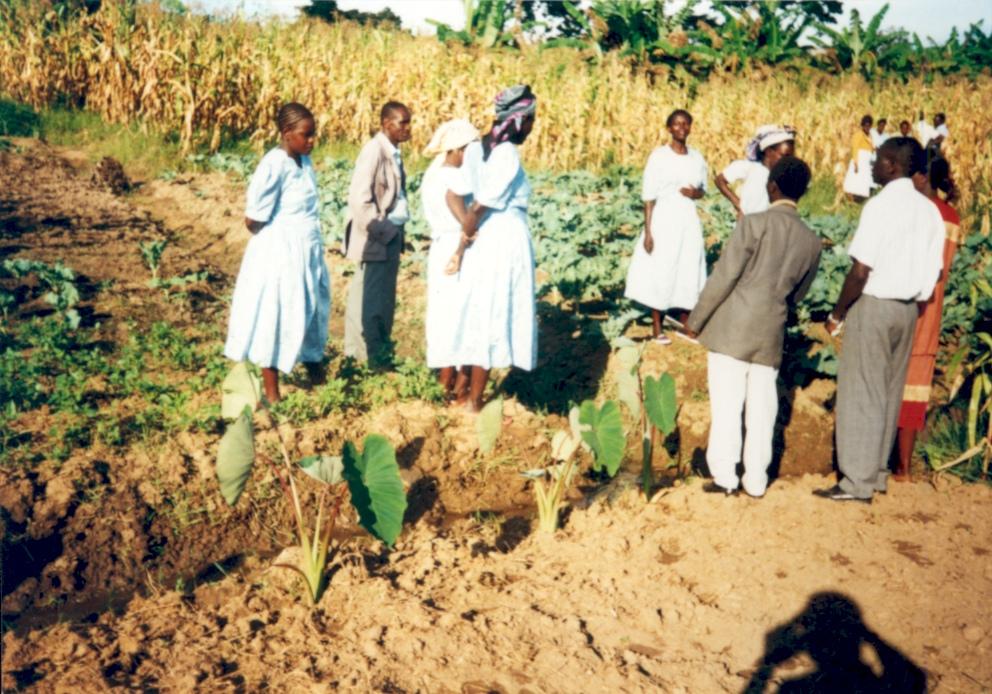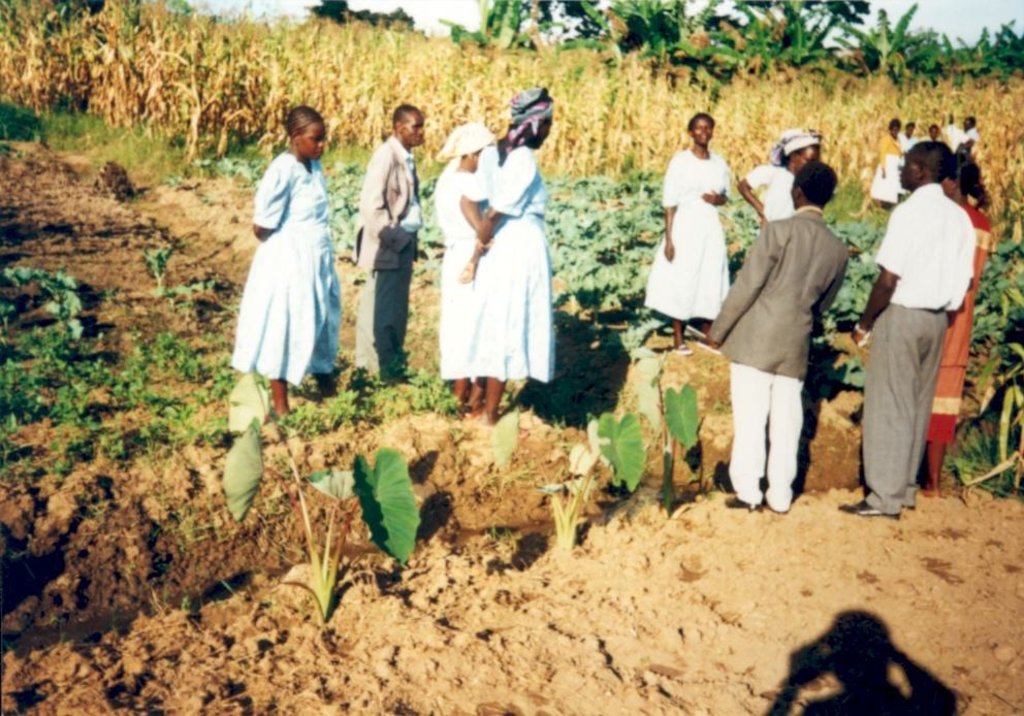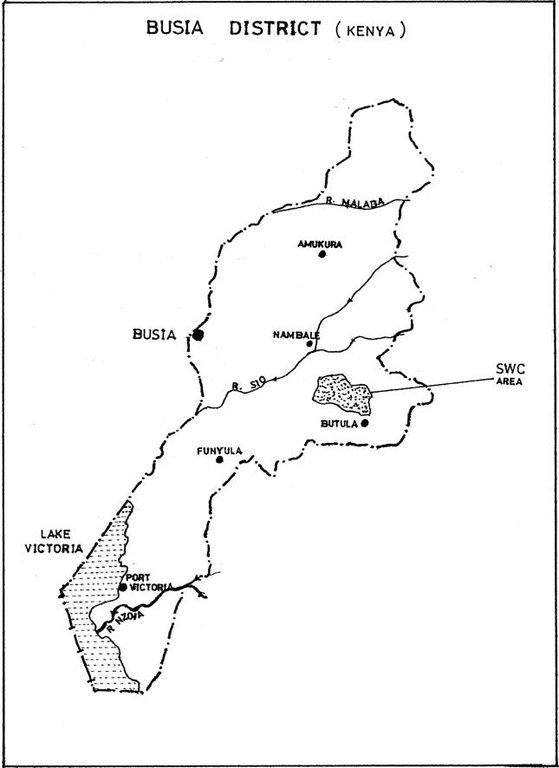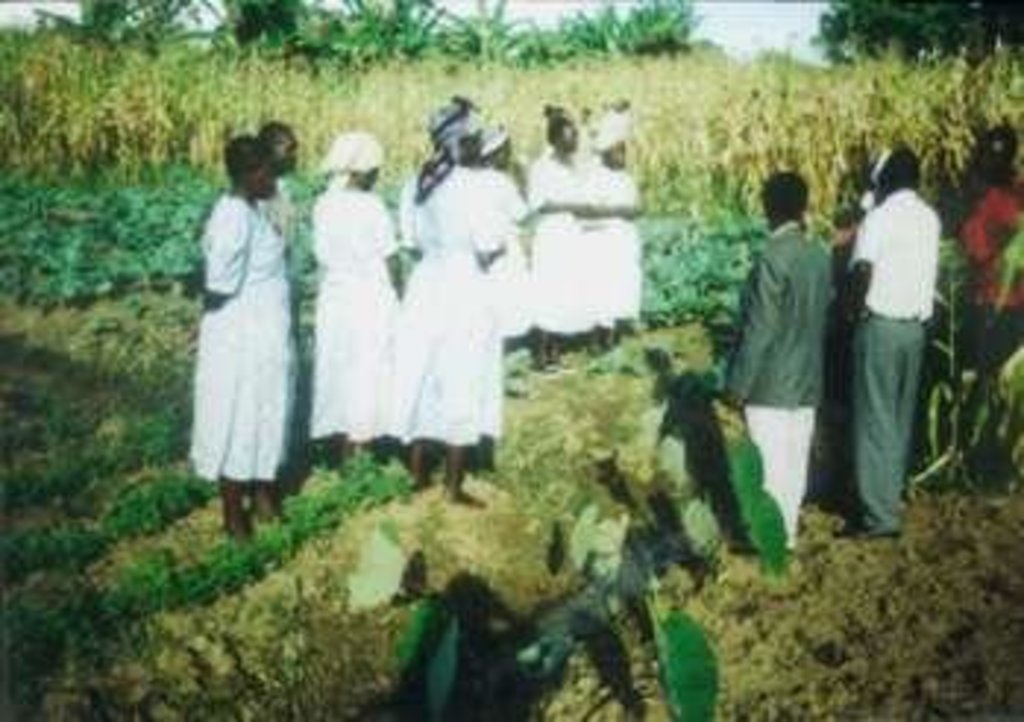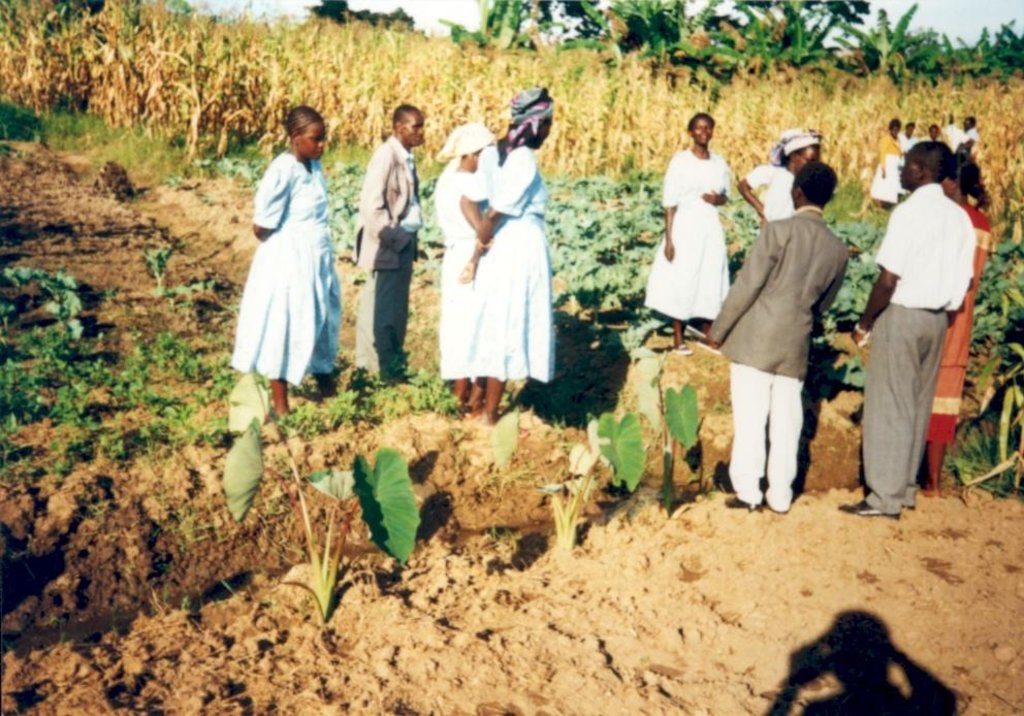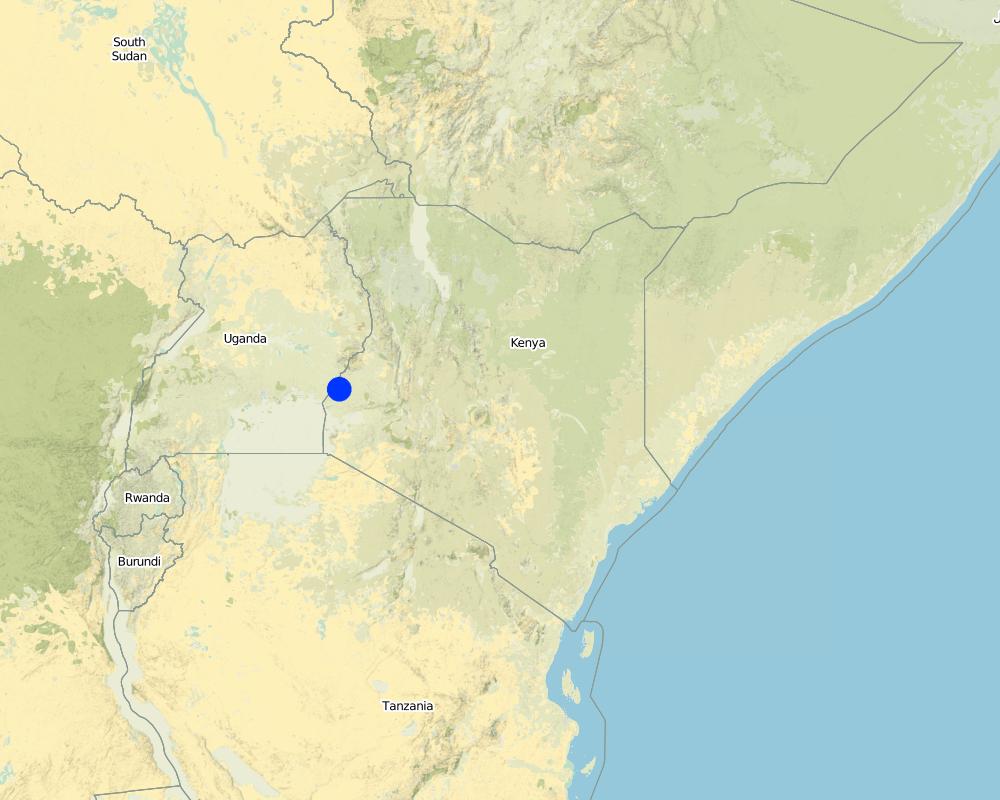Women Group Approach - Busia [肯尼亚]
- 创建:
- 更新:
- 编制者: Unknown User
- 编辑者: –
- 审查者: Fabian Ottiger
approaches_2359 - 肯尼亚
查看章节
全部展开 全部收起1. 一般信息
1.2 参与方法评估和文件编制的资源人员和机构的联系方式
关键资源人员
SLM专业人员:
Bittar Odoyo
肯尼亚
SLM专业人员:
Owendo Thomas Junior
MOARD
Box 28. Busia
肯尼亚
1.3 关于使用通过WOCAT记录的数据的条件
编制者和关键资源人员接受有关使用通过WOCAT记录数据的条件。:
是
2. SLM方法的描述
2.1 该方法的简要说明
group approach where women groups are visited by local specialists for on-farm demonstrations on use of double dug beds
2.2 该方法的详细说明
该方法的详细说明:
Aims / objectives: Women group approach to promote vegetable growing for improvement of food availability to the home and improvement of moisture availability and rooting depth in the home gardens. Improve moisture availability and rooting depth in the home gardens.
Methods: Group farm is used for demonstrating the performance of the technique and after seeing the benefits the individualmembers of the group are expected to transfer the technology into their own farms. At the group level, the group plot is used as a teaching class for all the members where they observe and participat in the preparation of the beds, planting, weeding upto harvesting of the produce. The produce is sold to raise funds for the groups investiments
2.3 该方法的照片
2.5 采用该方法的国家/地区/地点
国家:
肯尼亚
区域/州/省:
Western/Busia
Map
×2.6 该方法的开始和终止日期
注明开始年份:
1994
终止年份(若不再采用该方法):
2000
2.7 方法的类型
- 基于项目/方案
2.8 该方法的主要目的/目标
The Approach focused mainly on SLM with other activities (Fertility improvement, kitchen gardening, nutritional improvement)
promote food production for rural families through techniques that enhance moisture availability. - to target the women who are the main producers to ensure food availabity for the whole family
The SLM Approach addressed the following problems: food security for the rural farm families and inadequate moisture availability for vegetable production on kitchen gardens. Poor nutritional provision for rural families.
2.9 推动或妨碍实施本办法所适用的技术的条件
社会/文化/宗教规范和价值观
- 阻碍
Gender responsibilty hinders women from making major decisions on the farms like SWC development.
Treatment through the SLM Approach:
财务资源和服务的可用性/可得性
- 阻碍
for hiring labour for construction/ establishment
Treatment through the SLM Approach:
法律框架(土地使用权、土地和水使用权)
- 启动
The existing land ownership, land use rights / water rights moderately helped the approach implementation: each family has own land and thus motivated to improve its productivity through double beds
- 阻碍
men have the ownership of the title deds
Treatment through the SLM Approach: involve men during technology disemination to give support.
其他
- 阻碍
lack of adequate manure for improvement of soil fertility
Treatment through the SLM Approach: Involving men in the womenr group o appreciate the effort of women and back them
3. 相关利益相关者的参与和角色
3.1 该方法涉及的利益相关者及其职责
- 当地土地使用者/当地社区
Working land users were mainly women (the core target groups were women through women groups but individual farmers were also targeted)
Objective was to improve food availability for kitchen gardens and involve more women than men. Men only provided backing to women. Men make major decisions on farm development. The women groups comprise women from both poor and average wealthy, who are governed by rules of their groups. Some few men are incorporated in these groups for supporting women
- NGO
KIOF - Young mens christian association (YMCA-Busia)
3.2 当地土地使用者/当地社区参与该方法的不同阶段
| 当地土地使用者/当地社区的参与 | 指定参与人员并描述活动 | |
|---|---|---|
| 启动/动机 | 互动 | Mainly:public meetings; partly: workshops/seminars; the groups were sensitised through meetings with specialists. Field training/demonstrations were also carried out |
| 计划 | 自我动员 | public meetings; the women group members were invited for meetings by specialists where activities planning was carried out. |
| 实施 | 互动 | Mainly: group work; partly: casual labour; rich farmers can afford hired labour, but others benefit from group work |
| 监测/评估 | 无 | |
| Research | 无 |
3.4 有关SLM技术选择的决策
具体说明谁有权决定选择要实施的技术:
- 主要是SLM专家,咨询土地使用者之后
解释:
Consultative. The technology was on trial stage initially through few groups but the demand increased
Decisions on the method of implementing the SLM Technology were made by mainly by SLM specialists with consultation of land users. Land user driven (bottom-up). Specialists exposed the land users who later demanded it through women groups
4. 技术支持、能力建设和知识管理
4.1 能力建设/培训
是否为土地使用者/其他利益相关者提供培训?:
是
明确受训人员:
- 土地使用者
- school children/students, teachers
培训形式:
- 农民对农民
- 示范区域
- 公开会议
涵盖的主题:
manure handling and quality maintenance, compst making and moisture conservation
4.2 咨询服务
土地使用者有权使用咨询服务吗?:
是
指明是否提供了咨询服务:
- 在土地使用者的土地上
说明/注释:
Name of method used for advisory service: women group visits and training; Key elements: group demonstrations and farm visits, individual member farm visits, participatory learning and doing; 1) Mainly: non-governmental agency, Partly: government's existing extension system 2) Mainly: non-governmental agency, Partly: government's existing extension system; Extension staff: mainly government employees 3) Target groups for extension: land users; Activities: demonstration on establishment of double beds
Advisory service is very adequate to ensure the continuation of land conservation activities; the NGO promoting the technology had few staff and was mainly relying on government extension in the project area
4.3 机构强化(组织发展)
是否通过这种方法建立或加强了机构?:
- 是,适度
具体说明机构的强化或建立程度:
- 本地
具体说明支持类型:
- 能力建设/培训
4.4 监测和评估
监测和评估是该方法的一部分吗?:
是
注释:
economic / production aspects were ad hoc monitored
area treated aspects were regular
no. of land users involved aspects were regular
management of Approach aspects were None
There were no changes in the Approach as a result of monitoring and evaluation
4.5 研究
研究是该方法的一部分吗?
是
- efficiency of the system
提供进一步的细节,并指出是谁做的研究:
determined through its potential to increase yields of crops
Research was carried out on-farm
5. 融资和外部物质支持
5.1 该方法中SLM组成部分的年度预算
如果不知道准确的年度预算,请给出一个范围:
- 2,000-10,000
注释(例如主要的资助来源/主要捐助者):
Approach costs were met by the following donors: national non-government (-): 20.0%; local community / land user(s) (-): 80.0%
5.2 为土地使用者提供财政/物质支援
土地使用者是否获得实施该技术的财政/物质支持?:
否
5.3 对特定投入的补贴(包括劳动力)
- 设备
| 具体说明哪些投入得到了补贴 | 程度如何 | 对补贴做出具体说明 |
|---|---|---|
| 工具 | ||
- 农业
| 具体说明哪些投入得到了补贴 | 程度如何 | 对补贴做出具体说明 |
|---|---|---|
| 种子 | ||
| 化肥 | ||
注释:
Women group members worked on each others farm
5.4 信用
是否根据SLM活动的方法给予信用值?:
否
6. 影响分析和结论性陈述
6.1 方法的影响
该方法是否帮助土地使用者实施和维护SLM技术?:
- 否
- 是,很少
- 是,中等
- 是,支持力度很大
increase the depth of tillage and use of manure to improve moisture availability and fertility of land.
Did other land users / projects adopt the Approach?
- 否
- 是,很少
- 是,中等
- 是,支持力度很大
four other NGOs are using the approach of extension through women groups
6.3 方法活动的可持续性
土地使用者能否维持通过该方法实施的措施(无外部支持的情况下)?:
- 不确定
6.4 该方法的长处/优点
| 土地使用者眼中的长处/优势/机会 |
|---|
| improves vegetable supply for the kitchen |
| improves nutrition |
| better yields |
| increased moisture |
| the approach has helped them to learn from one another. |
| encouraged development of leadership skills |
| 编制者或其他关键资源人员认为的长处/优势/机会 |
|---|
| key members of the family, woman/children (How to sustain/ enhance this strength: the women group can be tranformed into a group to provide soft credit to facilitate commercial production of vegetables to pay back for the investiment) |
| acts as group pressure for adoption |
| trains farmers in their familiar surroundings |
| women form the backbone of farmers and are best target |
6.5 该方法的弱点/缺点以及克服它们的方法
| 土地使用者认为的弱点/缺点/风险 | 如何克服它们? |
|---|---|
| unfair distribution of benefits by inactive members. |
| 编制者或其他关键资源人员认为的弱点/缺点/风险 | 如何克服它们? |
|---|---|
| encouraged laziness for certain individuals | duty roster and division of responsibility |
| suppressing of the opinion of the weak ones |
链接和模块
全部展开 全部收起链接
无链接
模块
无模块


